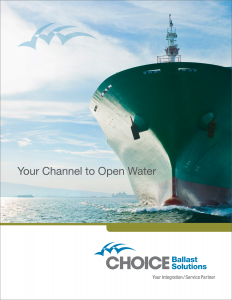On 1 March 2018, RADM Nadeau signed Navigation and Vessel Inspection Circular (NVIC) NVIC Ballast Water Management for Control of Non-Indigenous Species in Waters of the United States (NVIC 01‑18) replacing the 2004 NVIC. The NVIC is updated guidance on all aspects of ballast water management (BWM) in US waters and provides information on interactions with the various Captains of the Port (COTP).
The NVIC covers a wide range of BWM topics, of which the items below may be of particular interest:
- Guidance on USCG Accepted Alternate Management Systems (AMS) use and failures: The guidance differentiates between failures before a vessel’s compliance date and those after. If the AMS fails before the vessel’s compliance date, the USCG BWE is an option for the ship without direction from the local COTP. If the AMS fails after the vessel’s compliance date, one of the other BWM practices needs to be used, but ballast water exchange (BWE) needs to be approved by the appropriate COTP.
- Further clarification on the Preload tanks with regard to the definition of ballast water and applicability to the USCG regulations: The NVIC states that “Preload tanks are not considered ballast tanks … unless the tank is used to control or maintain trim, draft, stability of, or stresses on the unit or vessel during transit from one location to another”.
- BWM Reporting Guidance and Recordkeeping: The information provided is the same as previously reported for the USCG.
- Compliance Guidance: Further details on problems with USCG type approved ballast water management system (BWMS) and USCG accepted AMS are described. Guidance on the discharge of ballast water in extraordinary circumstances and suggested inclusion in vessel-specific ballast water management plans (BWMPs) is provided. Four circumstances are covered:
- Circumstance 1: Great Lakes/Hudson River (Subpart C) operations before USCG discharge standard compliance date,
- Circumstance 2: Great Lakes/Hudson River (Subpart C) operations after USCG discharge standard compliance date,
- Circumstance 3: Vessels not operating in Great Lakes/Hudson River (Subpart D) before USCG discharge standard compliance date, and
- Circumstance 4: Vessels not operating in Great Lakes/Hudson River (Subpart D) after USCG discharge standard compliance date. This section deals with inoperable BWMS.
- USCG Extensions: The NVIC does not list any new requirements but states that extensions will continue for the minimum time required. In comparison to previous extension applications, additional documentation may be required to support the request, but no new forms or documents are specifically identified. The NVIC mentions that extensions will “generally” not be longer than 12 months, but this may depend on the vessel’s timeline to BWMS installation and supporting justification.
- Compliance Verification. The USCG inspection and examination process is described. The minimum actions include:
- Determination as to which of the approved BWM methods the vessel is using to meet the ballast water discharge standards,
- Verify the BWMP is onboard and contains the required topics,
- Assessment of the crew’s familiarity with essential shipboard procedures pertaining to ballast water compliance,
- Inspection of visible portions of the vessel hull, anchor chain, and anchor for growth of organisms and sediment buildup,
- If a USCG type approved BWMS is installed, verification that the BWMS has the appropriate manufacturer’s nameplate, the Operation, Maintenance, and Safety Manual (OMSM) is on board, and sampling ports are in compliance with U.S. regulations,
- If an AMS is installed, verification that the system is on the list of USCG accepted AMS,
- If the vessel has a compliance date extension letter issued by the Coast Guard, determination as to whether the vessel’s discharge of ballast water into U.S. waters complies with the conditions specified on the extension letter,
- For vessels using ballast water from a U.S. Public Water System, examination of records that validate that the vessel’s tanks were cleaned before it accepted U.S. PWS water and a review the documentation (receipt, invoice, or other documentation) from the U.S. Public Water System.
- Confirmation as to whether ballast water records are kept in accordance with US requirements.
- Review of the ballast water report for the vessel’s current visit, if applicable, to determine if reporting has been appropriate.
- Enforcement: The various BWM enforcement options are described.
Choice Ballast Solutions is pleased to discuss any concerns and clarify any of the information provided. Go to info@choiceballast.com or call +1 440 973 9841.


